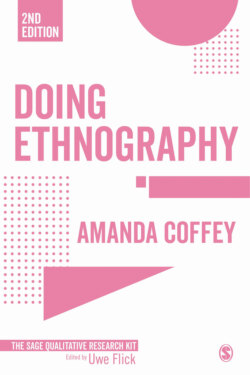Читать книгу Doing Ethnography - Amanda Coffey - Страница 21
На сайте Литреса книга снята с продажи.
Designing an ethnographic project
ОглавлениеPlanning an ethnographic research project is both exciting and challenging, precisely because of the lack of a tightly bounded or formulaic approach to research design. Ethnography relies on a close and detailed engagement with a setting, community or group of social actors, and is predicated on an understanding that we learn ‘about’ by being ‘with/in’. Thus, it follows, that an important aspect of an ethnographic project is the ‘getting on with it’ – involvement in the setting quickly and in ways that promote engagement and understanding. This might include observing, listening, asking questions, and indeed gathering any and all information you can lay your hands on – including documents, photographs and other materials from and about a setting. Such an immediate approach to ethnographic fieldwork is, to an extent at least, encouraged and supported by and through the theoretical foundations on which ethnographic research sits – with a focus on an inductive approach to theory building; generating ideas and analyses ‘bottom up’, from the ground and with an open mind. How better to pursue this than by moving forward quickly with fieldwork? And there is merit in such a timely approach, certainly with not delaying early data collection unnecessarily in favour of lengthy desk-based preparation time. Ethnographic research is often best served by early engagement and dialogue with the field of study. However, it is a mistake to think that there is an absence of preparedness or research design in ethnography. Like in all social scientific research, in ethnographic study there are choices to be made, issues of research design (Flick, 2018a) to address and to decide upon with thoughtfulness and care. While it is important not to predetermine the outcomes or experiences of fieldwork, or be overly prescriptive (we should always be prepared to be surprised and to be flexible in our approach), preparedness is still key to a successful ethnographic project.
There are a number of aspects of ethnographic research design that require careful consideration and at least a degree of planning. These include defining an initial research ‘problem’, question or topic for exploration and investigation, and identifying data collection and analytical strategies for the ways in which those ideas will be taken forward, developed and refined. The research setting and/or participants must also be identified, and this in itself might well involve preliminary research and fieldwork. There are real choices for the ethnographer in relation to generating data, managing data and undertaking analyses; not least because ethnography speaks to and includes a variety of approaches. Equally there are a range of ways in which ethnographic research can be written about, represented and reported. Ethnographic research, with its repertoire of methods, is also particularly well suited to be used in combination with other complementary approaches, thus prompting further issues for thoughtful research design. If and when ethnography is used in combination, good design is required to ensure that the final project benefits from the sum of the parts.
